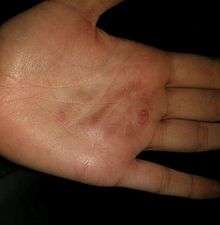Salt and ice challenge

The Salt and ice challenge is an Internet challenge where participants pour salt on their bodies, usually on the arm, and ice is then placed on the salt.[1] This causes a "burning" sensation similar to frost bite, and participants vie to withstand the pain for the longest time. The challenge can be recorded and posted on YouTube or other forms of social media.[2]
The mixture of ice and salt creates a eutectic frigorific mixture which can get as cold as −18 °C (0 °F),[3][4] much colder than ice alone. This repeatable cooling reaction was used to calibrate the Fahrenheit temperature scale.
The salt and ice challenge can quickly cause second- and third-degree injuries similar to frostbite or burning yourself with the metal end of a lighter, as well as causing painful open sores to form on the skin. Due to the numbing sensation of the cold and possible nerve damage during the stunt, participants are often unaware of the extent of any injuries sustained during the challenge. Skin discoloration from the challenge may remain after the challenge has been attempted.[5][6][7]
References
- ↑ Vang, Gia. July 29, 2030. "Experts: Don't Try 'Salt and Ice Challenge'". Retrieved June 28, 2013.
- ↑ Kuhn, Sherri. July 5, 2012. "The Salt and ice challenge: Don't let your teen get burned". Retrieved June 28, 2013.
- ↑ vinylogous. "Not the Lab". Retrieved 15 March 2016.
- ↑ "General Chemistry Online: FAQ: Solutions: Why isn't 0°F the lowest possible temperature for a salt/ice/water mixture?". Retrieved 15 March 2016.
- ↑ ""Ice and salt challenge" leaves 12-year-old Pittsburgh boy with second-degree burns - HealthPop". CBS News. 2012-07-02. Retrieved 2013-06-24.
- ↑ Kwak, Janet. "Ice-and-Salt Challenge Fires Up Health Officials | NBC Southern California". Nbclosangeles.com. Retrieved 2013-06-24.
- ↑ "Boy, 12, badly injured in 'salt-and-ice' challenge - Pittsburgh Post-Gazette". Post-gazette.com. 2012-06-29. Retrieved 2013-06-24.
External links
- The salt and ice challenge: Don't let your teen get burned
- Experts: Don't Try Salt and Ice Challenge